Home / Healthy Life / New Flavours
.png?width=346&height=346&name=Paediasure%20UK%20Mobile%20Images%20(2).png)
Pancake toppings for fussy eaters
See recipes
Getting creative with pancake toppings is a brilliant way to encourage your fussy eater to try new tastes and textures.
Pancakes are more than just a meal, they’re a fun foodie experience the whole family can share. Older kids will want to flip them. Youngsters will want to decorate them. What’s certain is that everyone will gobble them up faster than you can make them!
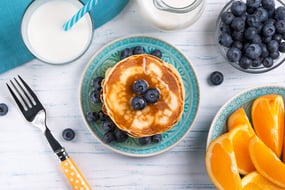
Why add pancake toppings at all?
In a word – nutrition. A basic pancake recipe contains eggs and milk, so that’s a great start. Check out our easy recipe enriched with PaediaSure Shake:
See Recipe
Eggs are high in protein and contain vitamins and minerals such as iron which is essential to your child’s health.1 Did you know eggs are one of only a handful of foods that contain vitamin D which helps to support the immune system? 2 Milk is a great source of calcium which is important for the development of healthy bones and teeth1. Add some nutritious pancake toppings and you ramp up the nutrition factor even further.
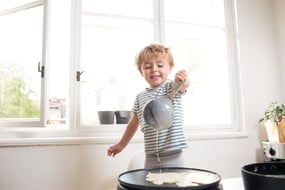
Savoury surprises
Pancakes aren’t just good for pud. On the continent, thin pancakes sometimes known as crêpes are often served with a scrummy savoury sauce. Cheese and ham make a tasty addition and are good sources of protein which is needed for normal growth and development of bone in children. Top tip: use a mild flavoured cheese if your little one isn’t a big fan yet. Once your pancake is starting to cook, sprinkle some grated cheese over one half, along with small pieces of ham. You could add a few spinach leaves too for extra fibre and a splash of colour. Then fold the pancake in half in the pan and slide onto a plate.

Sharing is all part of the fun
Why not cut your savoury pancake into wedges for the whole family to try? Tasting and talking about different flavours together can be a great way to tempt your little one to be more adventurous. They love copying what the grown-ups do! If you show how much you enjoy it, children are often more likely to give it a go.
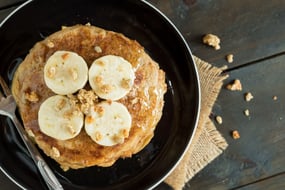
Tempting textures
Does your little angel struggle with texture as well as flavour? Adding crushed nuts or toasted seeds to the top of a pancake gives an enjoyable crunchꬷ. Walnuts contain omega 3 which supports children’s growth and development.* You could also add some chopped red pepper to your savoury pancake for a bit more bite. They’re also a great source of vitamin C4. Don’t be afraid to experiment with different nuts and veggies.
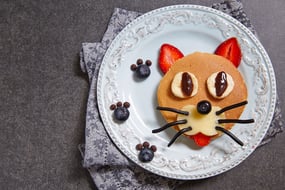
Create amazing fruity animals to tempt your little monkey
Pancakes are the perfect partner for just about any fruit you can think of. All you need is a little imagination to turn berries, grapes and bananas into beaks, ears, paws, tails… and hey presto, a whole plateful of animals. Just the thing to tempt your little monkey into trying something new! Encourage them to choose the fruit and decorate the pancakes themselves. The more involved they are, the keener they will be to sample their creation. Mee-wow! Check out our purrfect Cat Pancakes Recipe here.
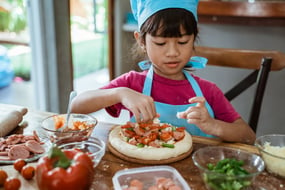
Perk up your pizzas
Tired of pancakes now? Homemade pizzas are another great option for experimenting with new flavours. Plus, they’re healthier than shop bought or takeaway pizzas as you know exactly what ingredients you put on them. Get everyone round the table, put a variety of ingredients into bowls - mozzarella, ham, pesto, pineapple, tuna, tomatoes, whatever you have to hand and have a Make My Own Pizza party!
Looking for more fussy eater tips?
We’d love to see how you get on - share pics of your pancakes and pizzas on our socials:
ꬷ Whole nuts and peanuts shouldn't be given to children under 5 years old, as they can choke on them. You can give your baby nuts and peanuts from around 6 months old, as long as they're crushed, ground or a smooth nut or peanut butter. If there's a history of food allergies or other allergies in your family, talk to your GP or health visitor before introducing nuts and peanuts.3
* Essential fatty acids are needed for normal growth and development of children. This beneficial effect is obtained with a daily intake of 10g linoleic acid and 2g alpha-linolenic acid.
Bibliography
1 https://www.nhs.uk/conditions/baby/weaning-and-feeding/what-to-feed-young-children/ Accessed 15th Jan 2021
2 https://www.ncbi.nlm.nih.gov/pmc/articles/PMC3166406/ Aranow C et al. J Investig Med. 2011; 59(6): 881–886. Accessed 15th Jan 2021
3 https://www.nhs.uk/conditions/baby/weaning-and-feeding/foods-to-avoid-giving-babies-and-young-children/ Accessed 15th Jan 2021
4 https://www.nhs.uk/conditions/baby/weaning-and-feeding/vitamins-for-children/ Accessed 15th Jan 2021


Join our family!
To get a discount coupon, discover fuss-free recipes, free meal planners and top tips.




